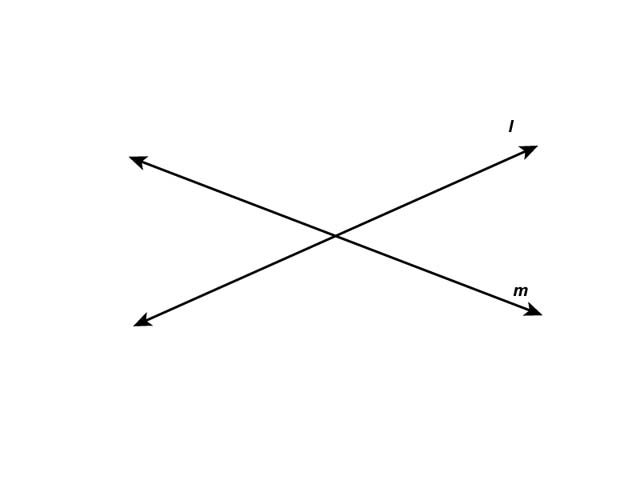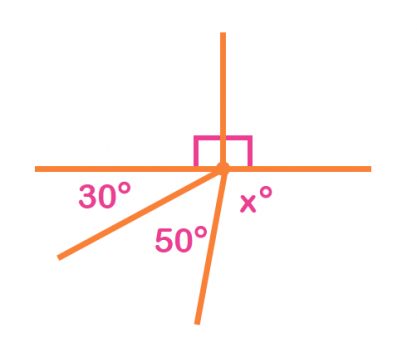These lines are _________ each other.

intersecting
When two angles add up to 90°, they are called ______________ angles.
What are these angles called? What can you tell me about them?
Angles at a point. Angles at a point add up to 360°
What is wrong about this diagram?
The corresponding angles rule does not apply because the lines are not parallel.
So, x and y do not have the same value.
Find the missing value represented by x°
Explain how you got your answer.

Angles at a point add up to 360°
Right angles are 90°
360° - 90° - 90° - 50° - 30° = 100°
x = 100°
What type of lines are these? What is the rule behind them?
Parallel lines. They cannot intersect.
When two angles add up to 180°, they are called ______________ angles.
supplementary
What are these angles called? What can you tell me about them?
Vertically opposite angles. When two straight lines intersect, the two angles opposite each other have the same value.
What type of angles are these? What can you tell me about them?
Alternate angles.
When two parallel lines are intersected by another line, the two angles on opposite ends of the two intersections have the same value.
Hint: look for the Z
Find the missing values represented by b, c and d.
Explain how you got your answer.
b = 140° (supplementary angles add up to 180°)
c = 40° (vertically opposite angles have the same value)
d = 140° (supplementary angles add up to 180° / angles at a point add up to 360°)
What type of lines are these? What is the rule behind these lines?
Perpendicular lines. They make a 90° angle (right angle) where they intersect.
What type of angle is this? How can you tell?
Find the missing value represented by x.
Supplementary angle. The angles are on a straight line, which means they add up to 180°.
180° - 130° = 50°
What type of angle is this?
Find the missing value represented by x and explain how you found it.
Vertically opposite angle.
x = 117°
Vertically opposite angles on intersecting straight lines have the same value
What type of angles are these? What can you tell me about them?

Corresponding angles.
When two parallel lines are intersected by another line, the angles found in the same position at the two intersections have the same value.
Hint: look for the F
Find the missing values represented by x, y and z.
Explain how you got your answer.

x = 74° (alternate angles have the same value)
y = 74° (vertically opposite angles have the same value)
z = 106° (supplementary angles add up to 180° / co-interior angles add up to 180°)
What do we call the point where two rays meet to form an angle? It is represented by P in the diagram.

Vertex
What type of angle is this? How can you tell?
Find the missing value represented by x.

Complementary angle.
The right angle symbol shows that these angles add up to 90°.
90° - 62° = 28°
x = 28°
What type of angle is this?
Find the missing value represented by e and explain how you found it.
Angles at a point.
Angles at a point add up to 360°.
360° - 146° - 117° = 97°
e = 97°
What type of angles are these? What can you tell me about them?
Co-interior angles.
When two parallel lines are intersected by another line, the angles at the two intersections which face each other add up to 180°
Hint: look for the C
Find the missing value represented by θ
Explain how you got your answer.
180° - 120° = 60° (a and d are co-interior angles which add up to 180°)
a = 60° θ = 60° (a and θ are vertically opposite angles)
OR
180° - 120° = 60° (d and c are supplementary angles which add up to 180°)
c = 60° θ = 60° (c and θ are corresponding angles)
OR
d = 120° b = 120° (d and b are alternate angles)
180° - 120° = 60° (b and θ are supplementary angles which add up to 180°)
θ = 60°

